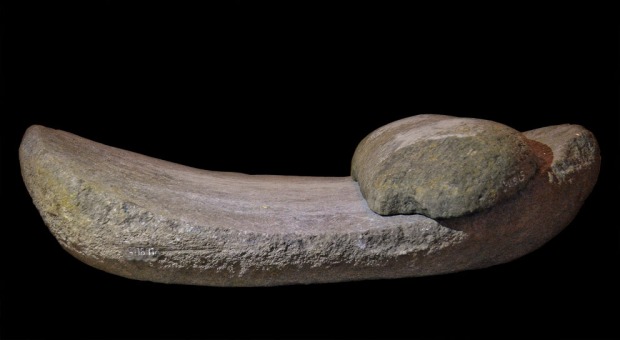
My favourite saddle quern: Long, slim, beautifully curved, well-used: A true masterpiece. But it may have taken thousands of hours of hard grain-grinding work to get to this form. Who did it: A woman, of course! When: Sometime way back when, in the Neolithic, perhaps in the Bronze Age. On display at Archaeological Museum, University of Stavanger, item no. S11891. Photo by Per Storemyr
The basement of the Archaeological Museum at Stavanger University holds the largest collection of grinding stones and querns found at archaeological excavations in Norway. Dating from the Neolithic to the Middle Ages, they show the development from saddle querns to standardised rotary hand querns. The finest querns are on display in the museum, and together with the magazine objects they particularly show the early development of the rotary hand quern in Norway: From 1800 year-old, very diverse specimens to the standardised, transportable rotary quern that we know so well from the Viking Age and later, and which became an important commercial trade good.
Thanks to Åsa Dahlin Hauken and Timothy Anderson – and the research conducted within the Millstone project, we now know that the rotary quern first turned up in Norway already in the Early Roman Iron Age; that is in the first two centuries AD. The oldest fragment of such a quern in the Stavanger magazines dates to c. 200 AD, found at the Forsandmoen farmstead.
It is probably not just by chance that the Stavanger Museum holds such a large amount of querns from the Roman period onward: Stavanger and Rogaland county are at the south-westernmost tip of Norway, comprising excellent farmland. And with good winds, the travelling time to the British Isles or Denmark would have been a couple of days in the olden days. Thus, people were confronted with items that the Romans brought up north during their expansions toward Scotland and the Netherlands.
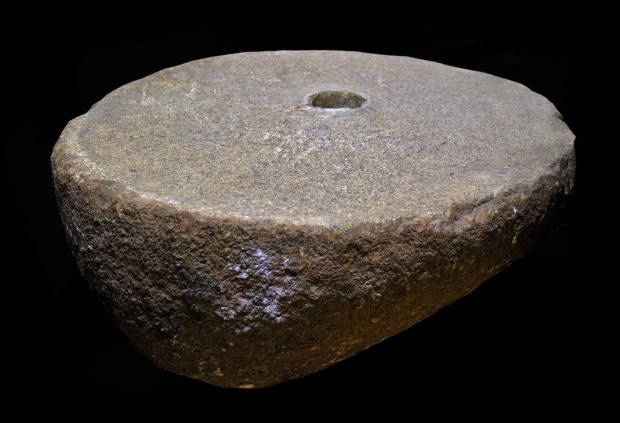
Split granite boulder used as a lower stone for a rotary hand quern. Found at Obrestad, dating to the Late Roman Iron Age (300-500 AD), diameter 56.5 cm. Archaeological Museum, University of Stavanger, inventory no. S6754ø. Photo by Per Storemyr
The hand-driven rotary quern was a key implement of the Roman world – and with the Roman legions. But the quern has a long story, starting in the Mediterranean region by 500 BC or beyond. It is the story of a quern gradually replacing traditional saddle querns – and a variety of intermediate querns. The reason is obvious: A rotary quern is more efficient than a saddle quern: people could grind more grain over a certain period of time than before. It is, simply, much easier to operate a rotary quern than a saddle quern.
Several of the earliest specimens in the Stavanger Museum look rather clumsy. They are quite large, with the lower stone split from erratic granite boulders found locally. Such rotary querns would have been stationary, half-buried in the ground, near the fire-place in the long-house, with hard clay or cloth or leather placed around to collect the flour as it came out from the periphery of the quern.
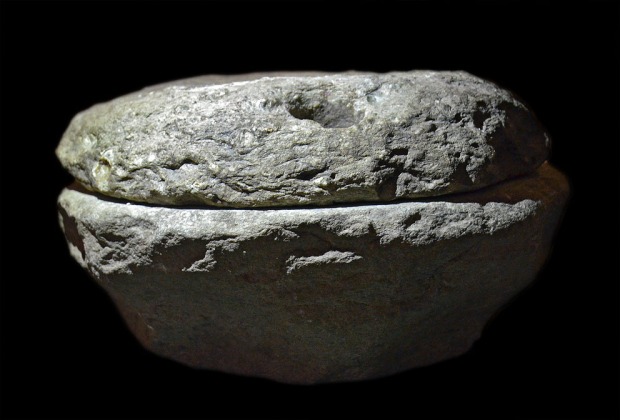
Split granite boulder used as a lower stone for a rotary hand quern. Found at Ullandhaug, dating to the 5th century AD, diameter 40.5 cm (inventory no. S9643 fnr. 111). The upper stone is also made from granite, but it was not in the same context as the lower stone (inventory no. S11759, c. 300 AD). Archaeological Museum, University of Stavanger. Photo by Per Storemyr
In the Migration and Merovingian periods (c. 400-800 AD), the form of the rotary hand quern tends to become more standardised and somewhat “lighter”, with the lower and upper stones forming a pair of rather slim stones, so well-known from the Roman period throughout the Mediterranean and Continental Europe, and from the Viking Age onward up north. These are highly transportable stones, which can be brought from site to site by pack animals (or, if you may, on the back of yourself – if you’d like to carry 2 x 25-40 kg…).
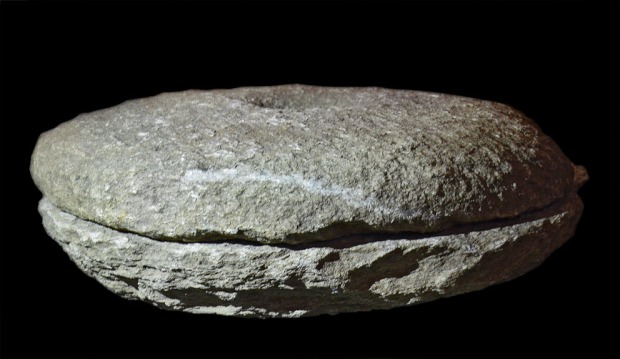
Pair of a rotary hand quern made from mica-rich gneiss found at Sørbø, c. 550 AD. Both the upper and lower stones are rather slim, diameter 46-47 cm. Archaeological Museum, University of Stavanger, inventory no. S12530.25. Photo by Per Storemyr
The standardised rotary hand quern is the forerunner of millstones in Norway; much larger stones that were driven by water power from, it is assumed, the early medieval period (1000-1100 AD). Thus, it took about a thousand years until the Roman water powered mill made its entry up north. But all of this is another story…
Acknowledgement and reference
Thanks to Åsa Dahlin Hauken of the Archaeological Museum in Stavanger, who were so kind to show me the exciting quernstone magazines at the museum a few days ago. Together with Timothy Anderson, Åsa has written a key report on the early rotary querns in Norway:
- Åsa Dahlin Hauken and Timothy J. Anderson (2014): Collection Report: Rotary Querns in the Museum of Archaeology, University of Stavanger. Project Millstone – The Norwegian Millstone Landscape. Report no. 2014.002. Geological Survey of Norway (with contributions by Gurli B. Meyer, Øystein Jansen and Tom Heldal). Download here.
…and by the way:
…here are two small models that may explain how the saddle quern and the rotary hand quern are operated. The first is 4000 years old, from Middle Kingdom Egypt, the other one is from today. I bought it a few years ago in Aswan, Egypt. Both querns are still used in various parts of Africa… Little has changed: In domestic situations, it was always women that made flour for the daily bread…
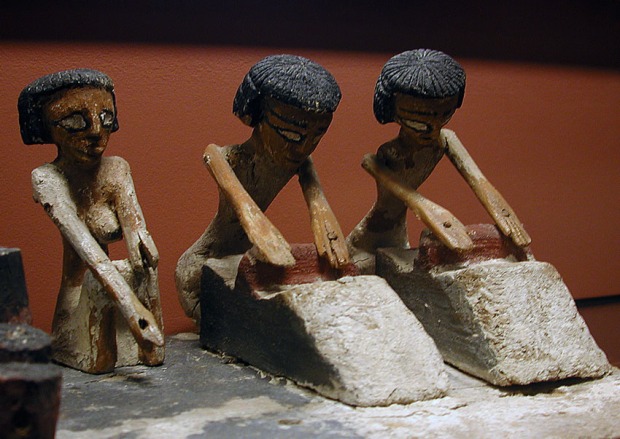
Women grinding grain with saddle querns. Middle Kingdom Egypt. Wooden model, Louvre Paris. Photo by Per Storemyr
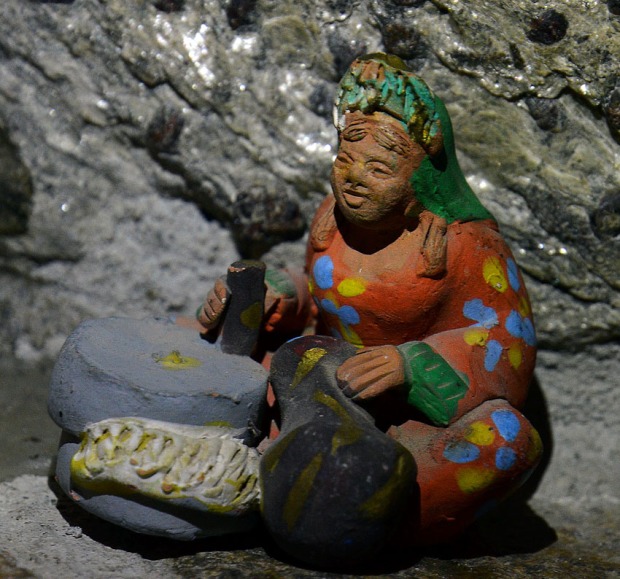
Woman grinding grain with a rotary hand quern. Modern clay model, Aswan, Egypt. Photo by Per Storemyr
Update 14.12.2015:
There has been an overwhelming response on this article on facebook, and there are lots of interesting comments on the use of old types of querns today. Se, for example, the comments in “Archaeology Trowels and Tools” (of Past Horizons):


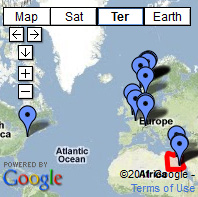
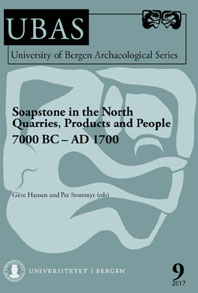

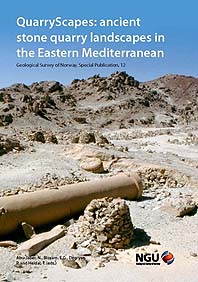

Pingback: January blog 2016 The Arctic is melting - who will best defend the Earth? - Ellen Evert Hopman
Pingback: Prehistoric women had extremely strong arms from a life of manual labor – News2K
Pingback: Prehistoric women had extremely strong arms from a life of manual labor – BioQt
Pingback: Noticias breves - Stone-ideas.com
Pingback: Kurz notiert - Stone-ideas.com
Pingback: Beautiful Neolithic and Iron Age querns from No...